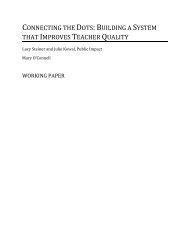Using Competency-Based Evaluation to Drive Teacher Excellence
Using Competency-Based Evaluation to Drive Teacher Excellence
Using Competency-Based Evaluation to Drive Teacher Excellence
Create successful ePaper yourself
Turn your PDF publications into a flip-book with our unique Google optimized e-Paper software.
Why examine Singapore<br />
Singapore’s rigorous teacher performance<br />
management system enjoys very high<br />
levels of support among teachers, policymakers,<br />
and government officials.<br />
Singapore has valuable lessons <strong>to</strong> offer U.S. policymakers<br />
because of its strengths in two important<br />
areas. First, as a country, Singapore has been able <strong>to</strong><br />
demonstrate extraordinary student learning results.<br />
For example, it consistently rates among the <strong>to</strong>p<br />
countries in the world on international rankings of<br />
student achievement in science, math, and literacy.10<br />
Second, Singapore’s rigorous teacher performance<br />
management system appears <strong>to</strong> enjoy very high levels<br />
of support among teachers, policymakers, and government<br />
officials.11 A survey conducted by the Ministry<br />
of Education in 2007, for example, found that<br />
the majority of teachers favored an even stronger link<br />
between performance and pay than the plan provided.12<br />
These facts alone suggest that we can learn<br />
something from Singapore’s approach <strong>to</strong> human<br />
capital management.<br />
An Overview. Singapore — a small island nation<br />
of 5.4 million people that sits at the southernmost<br />
tip of the Malaysian peninsula — became an au<strong>to</strong>nomous<br />
nation in 1965 (see Figure 1). From the outset,<br />
Singapore faced enormous challenges. It has no natural<br />
resources, a small land mass, and a relatively small<br />
population. Its immediate neighbors, Malaysia and<br />
Indonesia, are both poorer countries that have dealt<br />
with years of political turmoil, export dependency,<br />
and extreme poverty despite an abundance of natural<br />
resources. They serve as constant reminders of what<br />
Singapore has at stake. Meanwhile, the growing<br />
economic success of two of its largest neighbors —<br />
China and India — has created opportunities as<br />
well as challenges for Singapore.<br />
Its economic vulnerability may explain why Singaporeans<br />
<strong>to</strong>lerate a highly centralized government<br />
that practices what some observers refer <strong>to</strong> as “soft<br />
authoritarianism.”13 Government policy influences<br />
many aspects of people’s lives, including housing<br />
(most Singaporeans live in high-rise buildings in<br />
apartments that are subsidized by the government)<br />
and transportation (there are high taxes on cars, and<br />
the government severely restricts the number of cars<br />
on the road).<br />
Visi<strong>to</strong>rs <strong>to</strong> Singapore repeatedly hear that the<br />
country’s only national resource is its people, and<br />
that its viability as a country depends on its citizens’<br />
ability <strong>to</strong> contribute meaningfully <strong>to</strong> the world’s<br />
economy. Singapore’s eagerness <strong>to</strong> import talent from<br />
overseas is an indication of the value that various sec<strong>to</strong>rs<br />
of the economy, including education, place on<br />
academic achievement. While Singapore has an extremely<br />
stringent immigration policy for low-skilled<br />
workers, industry leaders are encouraged <strong>to</strong> attract<br />
talented people from overseas <strong>to</strong> become either permanent<br />
residents or citizens. This has led <strong>to</strong> a large<br />
and vibrant community of expatriates on the island,<br />
people from all over the globe who relocate <strong>to</strong> Singapore<br />
<strong>to</strong> work in industries such as finance, law, and<br />
health as well as education.<br />
Comparing Singapore <strong>to</strong> the United States. Singapore<br />
differs from the United States in several key<br />
respects. The scale and natural resources of the U.S.<br />
are dramatically larger, as is the size of the U.S. population<br />
and its political and economic role in world<br />
affairs. The education system in Singapore is tightly<br />
regulated by a centralized government, whereas in<br />
the United States, primary and secondary education<br />
fall largely under state and local, rather than federal,<br />
control. This makes Singapore more similar in size<br />
and governance <strong>to</strong> some U.S. states (e.g., Minnesota<br />
and Wisconsin) and even <strong>to</strong> a few of our largest<br />
urban school districts (e.g., New York City and Los<br />
Angeles).<br />
4 | lessons from singapore www.opportunityculture.org





